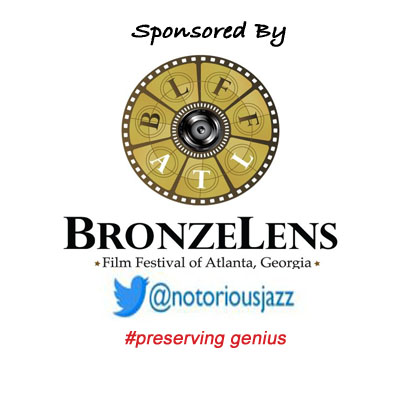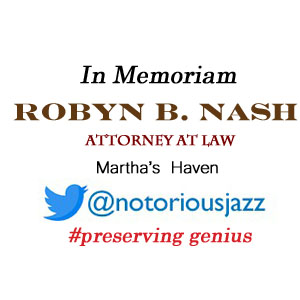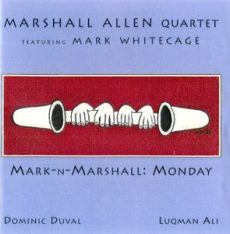
Daily Dose Of Jazz…
Marshall Belford Allen was born in Louisville, Kentucky on May 25, 1924. During World War II he enlisted in the 92nd Infantry Division and was stationed in France. He studied alto saxophone in Paris, France and played in Europe with Art Simmons and James Moody.
Best known for his mastery of explosive, jarring, chaotic sound effects on the alto saxophone, the opportunity came to create a long association with Sun Ra, with whom he performed almost exclusively from 1958 to Ra’s death in 1993. Marshall recorded with Paul Bley in 1964 and Olatunji during the mid-1960s.
Since Sun Ra death Allen has led the Arkestra and has recorded two albums. Allen often appeared in New York-area collaborations with bassist Henry Grimes, and participated in the Innerzone Orchestra with Francisco Mora Catlett, Carl Craig and others in an appreciation of Sun Ra’s music.
In 2022, the building at 5626 Morton Street known as the Arkestral Institute of Sun Ra was listed as a historic landmark in the Philadelphia Register of Historic Places. Free and avant-garde jazz alto saxophonist Marshall Allen, who also plays flute, oboe, piccolo, and EWI, at the age of 99 continues to live at the Institute, which has been his home since 1968.
More Posts: bandleader,ewi,flute,history,instrumental,jazz,music,oboe,piccolo,saxophone

Daily Dose Of Jazz…
Friedrich Gulda was born on May 16, 1930 in Vienna, Austria and as the son of a teacher began learning to play the piano at age 7 with Felix Pazofsky at the Wiener Volkskonservatorium. In 1942, he entered the Vienna Music Academy, where he studied piano and musical theory under Bruno Seidlhofer and Joseph Marx.
During World War II as teenagers, Gulda and his friend Joe Zawinul were rebellious and would perform forbidden music, including jazz, in violation of the government’s prohibition of playing such music. Winning first prize at the Geneva International Music Competition in 1946, he began to play concerts worldwide, making his Carnegie Hall debut in 1950, and with Jörg Demus and Paul Badura-Skoda, formed what became known as the “Viennese troika”. Friedrich enjoyed a renowned classical career for years before his 1956 engagement at Birdland in New York City and at the Newport Jazz Festival.
In 1966 he organized the International Competition for Modern Jazz in 1966, and established the International Musikforum, a school in Ossiach, Austria two years later, for students who wanted to learn improvisation. From the 1950s on Gulda cultivated a professional interest in jazz, writing songs and free improvisation or open music improvisations. He also recorded as a vocalist under the pseudonym “Albert Golowin”, fooling music critics for years until it was realized that Gulda and Golowin were the same person.
In jazz, he found “the rhythmic drive, the risk, the absolute contrast to the pale, academic approach I had been taught. He also took up playing the baritone saxophone. His 1970 album, As You Like It, includes the standards Round Midnight and What Is This Thing Called Love?, as well as his own classic Blues For H.G. that is dedicated to Hans Georg Brunner-Schwer.
From the late 1960s through the 1980s he continued his straight-ahead swing and bop-based jazz often in European Jazz big bands, which he often organized yearly performances and recordings. He performed and recorded playing clavichord, percussion instruments, and a bass recorder wooden flute with musicians involved in free improvisation, including Cecil Taylor, Barre Phillips, Ursula Anders, John Surman, Albert Mangelsdorff, Stu Martin, and Fritz Pauer. He would go on to collaborate in the coming decades with Herbie Hancock, Joe Zawinul, and Chick Corea.
When the Vienna Music Academy awarded him its Beethoven Ring in recognition of his performances, he accepted it but then later reconsidered and returned it. To promote a concert in 1999, he announced his own death in a press release so that the concert at the Vienna Konzerthaus could serve as a resurrection party.
Pianist and composer Friedrich Gulda, who worked in both the classical and jazz fields, transitioned from heart failure at the age of 69 on January 27, 2000 at his home in Weissenbach, Austria.
More Posts: bandleader,composer,history,instrumental,jazz,music,piano,saxophone
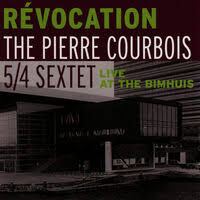
Daily Dose Of Jazz…
Pierre Courbois was born on April 23, 1940 in Nijmegen, Netherlands and after studying percussion at the Hogeschool der Kunsten in Arnhem, he left for Paris, France which was the center of jazz in Europe in the early 1960s. He worked with pianist Kenny Drew, violinist Jean-Luc Ponty, saxophonists Eric Dolphy, Ben Webster, Stan Getz, and Johnny Griffin, and guitarist René Thomas.
Courbois was one of the first musicians in Europe to experiment with free jazz. In 1961 he became the drummer and leader of the original Free Jazz Quartet. In 1965 he started another group, the Free Music Quintet, composed of international musicians. He also played and recorded with Gunter Hampel’s Heartplants Group with Manfred Schoof and Alexander von Schlippenbach.
Founding the first European jazz-rock group, Association P.C. in 1969, they won the Down Beat poll and stayed together until 1975. In 1982 Pierre put together the group New Association, and played with pianists Mal Waldron and Rein de Graaff, horn players Willem Breuker, Hans Dulfer and Theo Loevendie, and Ali Haurand’s European Jazz Quintet with Gerd Dudeck, Leszek Zadlo and Alan Skidmore.
In 1992 Courbois started a quintet and for the first time in his career performed pieces all composed by himself. This ensemble pleasantly surprised both the critics and the public with a return to the Charles Mingus tradition – thematic, melodic ensemble jazz and an experimentation with linear improvisation. Consistently reinventing himself he has gone on to create the Double Quintet, and the Five Four Sextet.
Drummer, bandleader and composer Pierre Courbois, who was awarded the Bird Award, the highest in the Dutch Jazz World and is a Knight of the Order of Orange-Nassau, continues to perform, record and compose.
More Posts: bandleader,drums,history,instrumental,jazz,music
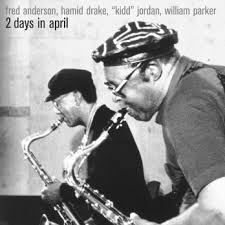
Daily Dose Of Jazz…
Fred Anderson was born in Monroe, Louisiana on March 22, 1929. When he was ten, his parents separated, and he moved to Evanston, Illinois, where he initially lived with his mother and aunt in a one-room apartment. When Anderson was a teenager, a friend introduced him to the music of Charlie Parker, and he soon decided he wanted to play saxophone, purchasing his first instrument for $45. He listened to Lester Young, Johnny Hodges, Dexter Gordon, Gene Ammons, and Illinois Jacquet, all of whom would influence his playing. He also heard Young and Parker in concert on multiple occasions.
Unlike many musicians at the time, Anderson did not play with dance bands or school ensembles, and instead focused on practicing, taking private lessons, and studying music theory at the Roy Knapp Conservatory in Chicago, Illinois all the while supporting his family by working as a waiter. He also began making an effort to develop a personal sound on his instrument, with the goal of combining Ammons’ big sound with Parker’s speed.
At around this time, he began to develop a series of exercises which he incorporated into his daily practice routine, and which eventually became a book titled Exercises for the Creative Musician.
In the early 1960s, Anderson began listening to and studying the music of Ornette Coleman, and immediately related Coleman’s playing to that of Charlie Parker. Influenced by Coleman, he formed a piano-less band with trumpeter Bill Brimfield, bassist Bill Fletcher, and drummer Vernon Thomas, playing a mixture of bebop standards and Anderson originals. During the decade he would go on to play weekly jam sessions, joined the AACM (Association for the Advancement of Creative Musicians) and remained in the States when many of his AACM colleagues left for Europe seeking better opportuities.
In the Seventies he formed the Fred Anderson Sextet, with trombonist George E. Lewis, reedist Douglas Ewart, bassist Felix Blackmon, drummer Hamid Drake, and vocalist Iqua Colson. By 1977 he and Brimfield visited Europe, where they recorded Accents with the Austrian trio Neighbours, then returned and opened a venue in Chicago that he named the Birdhouse, after Charlie Parker. Unfortunately, Anderson encountered resistance and harassment from officials and people in the neighborhood, who were suspicious of his motives, and he ended up closing the club a year later.
The following decade saw Fred taking over ownership of a bar in Chicago called the Velvet Lounge, and transformed it into a center for the city’s jazz and experimental music scenes, hosting Sunday jam sessions and numerous concerts. The club expanded and relocated in the summer of 2006.
Though he remained an active performer, Anderson rarely recorded for about a decade beginning in the early Eighties. In 1990, however, he received the first Jazz Masters Fellowship from Arts Midwest, and by the mid-1990s, he resumed a more active recording schedule, both as a solo artist, and in collaboration with younger performers. He would go on to perform as a soloist with 30 piece orchestras, mentor young musicians, and his Velvet Lounge has international fame.
Tenor saxophonist Fred Anderson, rooted in the swing, hard bop and free jazz idioms, who continued to record and tour throughout the 2000s and was scheduled to perform the day he died, transitioned on June 24, 2010.
More Posts: bandleader,history,instrumental,jazz,music,saxophone
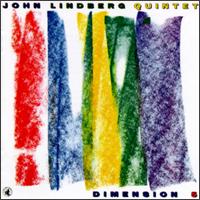
Daily Dose Of Jazz…
John Lindberg was born March 16, 1959 in Royal Oak, Michigan. He began his professional career at the age of 16, eventually moving to New York City in 1977. After moving to New York, he played with the Human Arts Ensemble alongside Joseph Bowie and Bobo Shaw. In 1977, with James Emery and Billy Bang. He co-founded the String Trio of New York.
In 1980 he formed a trio with Jimmy Lyons and Sunny Murray. From 1980 to 1983 he lived in Paris, playing there solo and with Murray and John Tchicai. He has recorded extensively as a leader. He studied bass with the bassist from the Battle Creek, Michigan symphony orchestra and jazz musician Roscoe Mitchell.
He has to date recorded twenty-five albums as a leader, eight with the String Tio of New York, and twenty with Anthony Braxton, Human Arts Ensemble, Susie Ibarra, Jimmy Lyons and Sunny Murray, Kevin Norton, Wadada Leo Smith and ten with Blob.
Double bassist John Lindberg continues to perform and record.
More Posts: bandleader,bass,history,instrumental,jazz,music


